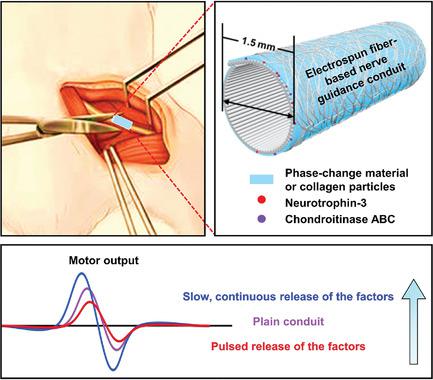当前位置:
X-MOL 学术
›
Adv. Healthcare Mater.
›
论文详情
Our official English website, www.x-mol.net, welcomes your
feedback! (Note: you will need to create a separate account there.)
Controlling the Release of Neurotrophin-3 and Chondroitinase ABC Enhances the Efficacy of Nerve Guidance Conduits.
Advanced Healthcare Materials ( IF 10.0 ) Pub Date : 2020-06-16 , DOI: 10.1002/adhm.202000200 Anthony Donsante 1 , Jiajia Xue 2 , Kelly M Poth 1 , Nathan S Hardcastle 1 , Bruna Diniz 1 , Deirdre M O'Connor 1 , Younan Xia 2, 3 , Nicholas M Boulis 1
Advanced Healthcare Materials ( IF 10.0 ) Pub Date : 2020-06-16 , DOI: 10.1002/adhm.202000200 Anthony Donsante 1 , Jiajia Xue 2 , Kelly M Poth 1 , Nathan S Hardcastle 1 , Bruna Diniz 1 , Deirdre M O'Connor 1 , Younan Xia 2, 3 , Nicholas M Boulis 1
Affiliation

|
Nerve guidance conduits (NGCs) have the potential to replace autografts in repairing peripheral nerve injuries, but their efficacy still needs to be improved. The efficacy of NGCs is augmented by neurotrophic factors that promote axon growth and by enzymes capable of degrading molecules that inhibit axon growth. In the current study, two types of NGCs loaded with factors (both neurotrophin‐3 and chondroitinase ABC) are constructed and their abilities to repair an 8 mm gap in the rat sciatic nerve are examined. The factors are encapsulated in microparticles made of a phase‐change material (PCM) or collagen and then sandwiched between two layers of electrospun fibers. The use of PCM allows to achieve pulsed release of the factors upon irradiation with a near‐infrared laser. The use of collagen enables slow, continuous release via diffusion. The efficacy is evaluated by measuring compound muscle action potentials (CMAP) in the gastrocnemius muscle and analyzing the nerve histology. Continuous release of the factors from collagen results in enhanced CMAP amplitude and increased axon counts in the distal nerve relative to the plain conduit. In contrast, pulsed release of the same factors from PCM shows a markedly adverse impact on the efficacy, possibly by inhibiting axon growth.
中文翻译:

控制 Neurotropin-3 和软骨素酶 ABC 的释放可增强神经引导导管的功效。
神经引导导管(NGC)具有替代自体移植物修复周围神经损伤的潜力,但其疗效仍需提高。促进轴突生长的神经营养因子和能够降解抑制轴突生长的分子的酶增强了 NGC 的功效。在当前的研究中,构建了两种负载因子(神经营养蛋白-3 和软骨素酶 ABC)的 NGC,并检查了它们修复大鼠坐骨神经 8 毫米间隙的能力。这些因子被封装在由相变材料(PCM)或胶原蛋白制成的微粒中,然后夹在两层电纺纤维之间。使用 PCM 可以在近红外激光照射下实现因子的脉冲释放。胶原蛋白的使用可以通过扩散缓慢、连续地释放。通过测量腓肠肌中的复合肌肉动作电位(CMAP)并分析神经组织学来评估疗效。胶原蛋白的持续释放导致远端神经相对于普通导管的 CMAP 振幅增强和轴突计数增加。相比之下,PCM 中相同因子的脉冲释放显示出对功效的显着不利影响,可能是通过抑制轴突生长来实现的。
更新日期:2020-07-22
中文翻译:

控制 Neurotropin-3 和软骨素酶 ABC 的释放可增强神经引导导管的功效。
神经引导导管(NGC)具有替代自体移植物修复周围神经损伤的潜力,但其疗效仍需提高。促进轴突生长的神经营养因子和能够降解抑制轴突生长的分子的酶增强了 NGC 的功效。在当前的研究中,构建了两种负载因子(神经营养蛋白-3 和软骨素酶 ABC)的 NGC,并检查了它们修复大鼠坐骨神经 8 毫米间隙的能力。这些因子被封装在由相变材料(PCM)或胶原蛋白制成的微粒中,然后夹在两层电纺纤维之间。使用 PCM 可以在近红外激光照射下实现因子的脉冲释放。胶原蛋白的使用可以通过扩散缓慢、连续地释放。通过测量腓肠肌中的复合肌肉动作电位(CMAP)并分析神经组织学来评估疗效。胶原蛋白的持续释放导致远端神经相对于普通导管的 CMAP 振幅增强和轴突计数增加。相比之下,PCM 中相同因子的脉冲释放显示出对功效的显着不利影响,可能是通过抑制轴突生长来实现的。











































 京公网安备 11010802027423号
京公网安备 11010802027423号